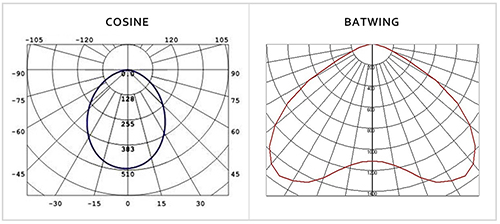Optimizing lighting distribution can improve lighting quality, energy savings, sales and profitability for distributors and contractors.
by Stan Walerczyk, HCLP, CLEP
Distribution, distribution, distribution can be as critical as location, location, location.
Where the light goes is important for two reasons. One is providing light where it is needed and preventing it going where it should not go. The other is with the very good optical control of well- designed LED products, additional energy can be saved avoiding the typical excessive blob of light underneath or in front of most other lighting technology products.
Cosine – batwing distribution will be discussed for both interior and exterior applications. Category 1 – 5 and backlight, uplight and glare (BUG) will be covered for exterior applications.
A cosine distribution directs most of the light straight down or straight in front, while a batwing distribution shines more angled light.
Although cosine distribution can be best for floods directed at a target, such as a photograph or a sign, batwing is usually best for troffers, troffer kits, LED lightbars, LED T8s and hibays.
Clear prismatic lensed troffers have a batwing distribution, at least perpendicular to the length of the fluorescent lamps, which is good, because it provide fairly uniform lighting directly underneath and between fixtures, and it also can provide decent lighting on walls.
But most LED troffers and troffer kits have a cosine distribution, so it may be too bright directly underneath, and it may not provide sufficient light between fixtures or on walls. This can be a significant concern with typical 8’ x 10’ spacing and less than 9’6” ceiling height.
There are some LED troffers and troffer kits with a batwing distribution in two directions, and at least the Philips Ledalite ArcForm LED troffer has a batwing distribution in all four directions, which can be called 3D. This is shown below.
In addition to providing a better uniformity, two direction or four direction batwing distribution troffers or troffer kits may be able to save energy.
Most HID and fluorescent hibays have a cosine distribution, which means there is an excessive blob of light directly underneath in order to provide sufficient light between fixtures and to appropriate borders. At least below 30’ LED hibays with a good batwing distribution can usually be a lower wattage, because there is still sufficient light underneath, between fixtures and to appropriate boundaries without that wasteful blob of excess light directly underneath.
Many exterior LED pole fixtures with a batwing distribution can save energy compared to both LED and HID fixtures that do not.
For most exterior pole fixtures it is important to specify, purchase and install the correct category type. These diagrams should be helpful. Manufacturers and others can provide more detailed information.

For exterior fixtures there is also BUG, which has replaced cut-off terminology. In this diagram, B stands for backlight, F stands for forwardlight and U stands for uplight. As mentioned above, G stands for glare.

One main difference is cut-off classifications did not change with higher lumen packages in a specific fixture, but BUG ratings can change with higher lumen packages.
BUG Classification System Information Resources:
The BUG System—A New Way To Control Stray Light from Outdoor Luminaires
Classifying Outdoor Luminaires: The Limits of BUG
Walerczyk is principal of Lighting Wizards, an independent energy efficiency consulting firm. He has over 25 years of lighting experience including distribution, maintenance, retrofit contracting, and industry research. An Association of Energy Engineers-Certified Lighting Efficiency Professional, he also holds a Lighting Certified designation from the National Council on Qualifications for the Lighting Professions. He can be reached at stan@lightingwizards.com.






